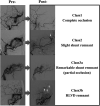Outcome of Endovascular Therapy Aiming for Single-session Obliteration of Intracranial Dural Arteriovenous Fistulas
- PMID: 34148944
- PMCID: PMC8531874
- DOI: 10.2176/nmc.oa.2021-0059
Outcome of Endovascular Therapy Aiming for Single-session Obliteration of Intracranial Dural Arteriovenous Fistulas
Abstract
The goal of dural arteriovenous fistula (dAVF) treatment is obliteration of the arteriovenous shunt and/or retrograde leptomeningeal venous drainage (RLVD). Single-session obliteration could improve symptoms early and reduce risk of neurological sequelae. This study investigated the efficacy and adverse events of endovascular therapy (EVT) aiming for single-session obliteration in dAVF treatment. We retrospectively examined post-treatment arteriovenous shunt status, number of treatments per case, treatment-related complications, and long-term outcome in 92 dAVF patients who underwent initial EVT at our institution. Single-session obliteration was intended in all cases, but a second session was performed in cases of partial shunt occlusion or remaining RLVD. Complete occlusion was achieved in 85 cases (92.4%) after the single session; RLVD was obliterated in 66 of the 67 Borden type II and III cases combined (98.5%). A second session was necessary in seven cases (7.6%). Complete shunt obliteration was eventually achieved in all cases. The average number of treatments was 1.08 per case. dAVF-related stroke and mortality did not occur after the treatment. On the other hand, radiation-induced skin erythema and alopecia, although all symptoms were transient, occurred in 26 cases (28.3%). Over an average 60.2-month follow-up period, recurrence was observed in seven cases (7.6%). Single-session obliteration was successful in 92% of cases. Especially, single-session obliteration of RLVD may contribute to early prevent of future stroke events. However, reducing total radiation dose during each session is an issue of further study.
Keywords: dural arteriovenous fistula; embolization; endovascular; radiation; session.
Conflict of interest statement
TS was supported by grants from CANON MEDICAL SYSTEMS CORPORATION, outside the submitted work. The authors declare that they have no conflict of interest.
Figures


References
-
- Cognard C, Gobin YP, Pierot L, et al. : Cerebral dural arteriovenous fistulas: clinical and angiographic correlation with a revised classification of venous drainage. Radiology 194: 671–680, 1995 - PubMed
-
- Davies MA, Ter Brugge K, Willinsky R, Wallace MC: The natural history and management of intracranial dural arteriovenous fistulae. Part 2: aggressive lesions. Interv Neuroradiol 3: 303–311, 1997 - PubMed
-
- Lucas CP, Zabramski JM, Spetzler RF, Jacobowitz R: Treatment for intracranial dural arteriovenous malformations: a meta-analysis from the English language literature. Neurosurgery 40: 1119–1130; discussion 1130-1132, 1997 - PubMed
-
- Borden JA, Wu JK, Shucart WA: A proposed classification for spinal and cranial dural arteriovenous fistulous malformations and implications for treatment. J Neurosurg 82: 166–179, 1995 - PubMed

